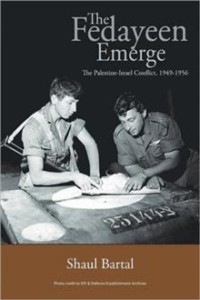Title: The Fedayeen Emerge: The Palestine-Israel Conflict, 1949-1956
Author: Shaul Bartal
Publisher: AuthorHouseUK
ISBN: 978-1-4567-8679-3
Pages: 436
Genre: Non-Fiction
Reviewed by: J.W. Bankston
Buy on Amazon
Pacific Book Review
Often misquoted and misattributed, it seems essayist George Santayana was the one who warned that, “Those who cannot remember the past are condemned to repeat it.” This advice could not be better applied than to the Palestinian-Israeli conflict. Yet how do we overcome our ignorance of the past when the subject is this complex, variable and inflammatory? By shedding light on events taking place over half-a-century ago, author Shaul Bartal illuminates today’s challenges. His book, “The Fedayeen Emerge: The Palestine-Israel Conflict, 1949-1956,” delivers the past as prologue.
Despite the book’s focus on the Palestinian side, it is for the most part an even-handed portrayal. This is due no doubt to Bartal’s experiences as a Major in the Israel Defense Forces reserves. With over 200 pages of endnotes, the book sometimes reflects its origins as a doctoral thesis (Bartal earned a PhD in Middle Eastern Studies at Bar-Ilan University in 2006). Yet it is generally a compelling read offering a clear-eyed view of a difficult situation.
The author addresses the anti-Zionist movements prior to modern Israel’s founding, but focuses the book on events following the adoption of United Nations Resolution 181 on November 29, 1947. This resolution supported the partition of the British Palestine- Israel mandate. Bartal delves into the subsequent challenges faced by the disparate Palestinian diaspora. Not only were neighboring Arab countries Jordan and Egypt reluctant to grant them citizenship, in the case of West Bank Palestinians their desires for autonomy were in direct conflict with the Jordanian monarchy. These differences appeared to dissolve on the day Israel declared independence and Lebanon, Syria, Jordan, Egypt and Iraq declared war: “This will be a war of extermination and a momentous massacre which will be spoken of like the Mongolian massacres and the Crusades,” declared the Arab League Secretary, General Azzam Pasha.
Instead, despite the odds, Israel prevailed. In the aftermath, the UN’s General Assembly’s Resolution 194 promised that “… refugees who wish to return to their homes and live in peace with their neighbors will be allowed to do so at the earliest practical date possible.” This “right of return” has been a motivating factor in the decades-long conflict. Throughout the book, Bartal examines “the infiltrations” –– the border-crossing activities of Palestinians. “The protest struggle of the Palestinian community began with the infiltrations by individuals who were persecuted by the Arab regimes on one side and the Israelis on the other side,” he points out.
The book is described as “the struggle of a defeated generation through its own eyes, the struggle of groups and individuals against a reality they could not accept.” In some cases, the “infiltrations” were motivated by a farmer’s simple desire to return to the crops he’d abandoned during the 1948 Israeli War for Independence. In other cases, the infiltrator’s actions were more seditious and violent. These accounts of early guerrilla warfare seem a clear precursor to the suicide bombers (and lately suicide stabbers) of the 21st century. These were the Fedayeen. Their actions and Israel’s response (which in some cases the author argues was disproportionate) is easily connected to current events. For anyone curious about the origins of the Palestinian-Israeli conflict, this compassionate study deserves to be high up on the “to be read” list.



Follow Us